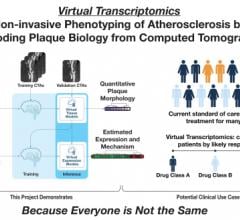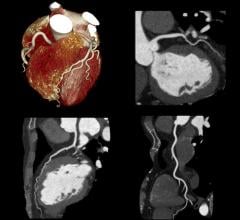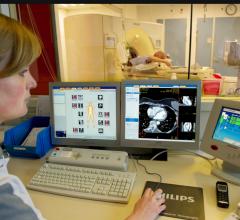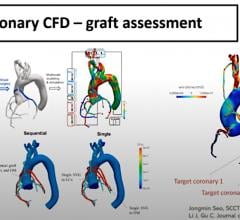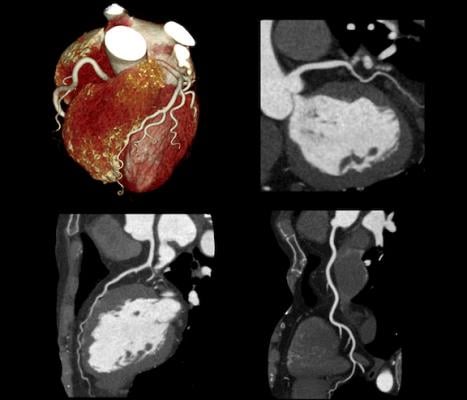
An example of a cardiac CT scan showing a 3-D reconstriction of the heart showing a stented vessel, and reformatted images showing the stented coronary artery with restenosis from different views. This was imaged using a Canon Aquilion Prime CT system.
September 8, 2020 — The Journal of the American College of Cardiology (JACC) published a report, “Current Evidence and Recommendations for Coronary CTA First in Evaluation of Stable Coronary Artery Disease” that outlines the benefits of a coronary computed tomography angiography (CTA)–first strategy, as well as challenges and barriers related to this approach.[1]
The report reflects expert consensus of attendees at the American College of Cardiology (ACC) Summit on Technology Advances in Coronary Computed Tomography Angiography, held in September 2019. It notes that despite evidence that a coronary CTA-first strategy can improve outcomes and may lower cost for patients with stable chest pain, the U.S ratio of nuclear single-photon emission CT (SPECT) myocardial perfusion imaging to coronary CTA testing is 58:1.
The statement outlines data that for patients who do not have known coronary artery disease (CAD), the detection of CAD should change from detection of a myocardial perfusion abnormality to detection of coronary atherosclerosis through a CTA-first strategy. The United Kingdom (U.K.) and the rest of Europe have changed their guidelines as a result of this evidence.
“The available evidence suggests that a coronary CTA-first strategy can provide important benefits to our patients, yet there are barriers to wider implementation, including inadequate payment, insufficient number of imagers (both cardiologists and radiologists) trained to interpret these tests, and a need for more education of referring physicians on when and how to utilize coronary CTA in patient care,” explained Society of Cardiovascular Computed Tomography (SCCT) Immediate Past President, Ron Blankstein, M.D., MSCCT, who was part of the planning committee for the ACC summit.
Per the report, shifting from other forms of imaging to coronary CTA is not without its challenges. While CT scanners are widely available, more education and training of medical professionals is needed to produce high quality imaging, in addition to higher reimbursement and improved insurance pre-authorization.
“In countries around the world, cardiac CT has been adopted as a first-line diagnostic test in patients with stable chest pain, and I have no doubt this strategy will be embraced in the U.S. as well if appropriate conditions can be established,” said SCCT President Koen Nieman, M.D., Ph.D., MSCCT.
Key Takeaways on How to Advance the U.S. Healthcare Systems to a Coronary CT First Approach
To move toward a coronary CTA-first paradigm, the ACC Summit attendees recommend the following:
• Use coronary CTA as a first-line test for evaluating patients with stable chest pain and low-to-intermediate pre-test probability of obstructive CAD.
• Increase payment for coronary CTA and improve advocacy for coronary CTA by direct engagement with public and private payers.
• Explore options for “bundled payments” for cardiac testing.
• Identify expert and financial support to increase the number of capable coronary CTA providers.
• Develop strategies to improve provider and delivery team competency in performing coronary CTA.
• Establish an ACC coronary CTA registry for evaluating chest pain. This registry could include medical and economic variables to evaluate “total cost of care” associated with coronary CTA.
• Engage commercial payers in discussions on eliminating pre-approvals for coronary CTA and fractional flow reserve CT (FFR-CT) for providers participating in the coronary CTA registry.
• Improve education of cardiologists and primary care physicians on when to consider coronary CTA testing vs. other techniques.
• The report provides evidence from the U.K. SCOTHEART (Scottish Computed Tomography of the Heart) trial, the U.S. PROMISE (Prospective Multicenter Imaging Study for Evaluation of Chest Pain) trial and early reports from the clinical trial ISCHEMIA (International Study of Comparative Health Effectiveness with Medical and Invasive Approaches).
Perverse Economic Incentives Do Not Account for New Technology Advances to Improve Care
The paper also details issues with how the U.S. reimbursement system is set up that largely prevents use of a CTA-first approach. The authors said the U.S. healthcare system is far behind the CT advancements of their international peers (U.K., Japan, Europe) in enabling a CTA-first approach due to the following factors:
1. The widespread availability and use of nuclear medicine cameras and stress echocardiography laboratories which continue the current treatment pathway.
2. Cardiovascular fellowship programs that predominantly emphasize functional over anatomic testing needed for a CTA-first approach.
3. The requirement of medical and technical expertise needed to produce consistent, high-quality imaging and interpretation for coronary CTA.
4. Large reimbursement disparities between coronary CTA and other cardiac imaging tests, despite similarity in cost.
5. Perverse economic incentives. The financial challenges are due to the U.S. healthcare financial system’s complexity, which has “inherently perverse economic incentives and often rewards the use of established, less effective practices as opposed to more innovative technologies offering improved medical outcomes with long-term cost reduction.”
About the Society of Cardiovascular Computed Tomography
Founded in 2005, the Society of Cardiovascular Computed Tomography (SCCT) is the international professional society devoted to improving health outcomes through effective use of cardiovascular computed tomography (CCT), with members from over 85 countries. SCCT is a community of physicians, scientists and technologists advocating for access, research, education and clinical excellence in the use of CCT. For more information, visit www.SCCT.org.
Related SCCT Cardiac CT Content:
New Technologies Take Cardiac CT to the Next Level
Key Trends in Cardiac CT at SCCT 2020
VIDEO: Increased Use of Cardiac CT During the COVID-19 Pandemic
VIDEO: Photon Counting Detectors Will be the Next Major Advance in Computed Tomography
VIDEO: Coronary Plaque Quantification Will Become Major Risk Assessment
VIDEO: Key Cardiac CT Papers Presented at SCCT 2020
VIDEO: Artificial Intelligence to Automate CT Calcium Scoring and Radiomics
Low-attenuation Coronary Plaque Burden May Become Next Big Cardiac Risk Assessment
Impact of Cardiac CT During COVID-19
Reference:


 March 07, 2024
March 07, 2024 




